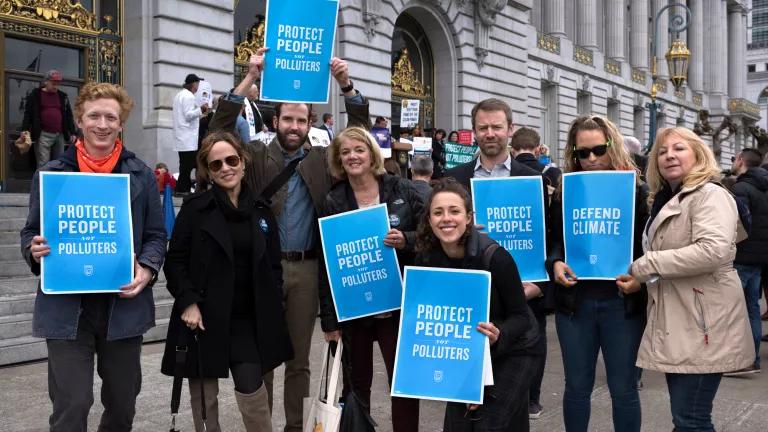A New Route to Protect our Health and Climate from Pollution

Smog season is getting underway throughout the U.S. This is the time of year when bad air pollution prompts those red and orange alerts, warning kids, people with asthma, the elderly—and just about everyone else—to minimize time outdoors. The American Lung Association estimates that nearly 140 million Americans—about half of our population—live in places where air pollution frequently poses a health threat.
Vehicles and other forms of transportation are a major source of the pollution that threatens our health. More than half of the smog-forming pollutants and more than a quarter of our climate-warming carbon pollution comes from our cars, trucks and other forms of transportation.
We’ve made significant progress in getting our cars and trucks to run cleaner in recent years. But even as we clean up what comes out of each tailpipe, we remain so reliant on cars and trucks in general that we still have big pollution problems.
Today, the US Department of Transportation took a step in the right direction by asking whether the agencies that develop transportation projects with federal dollars (such as roads, rails and public transit systems) should be required to measure the dangerous carbon pollution their transportation projects would produce and to take steps to reduce it.
NRDC thinks this is an important question (see our statement here) to ask because the federal government invests tens of billions of dollars annually ($46 billion in 2014) on highways and roads projects recommended by state and regional planning agencies, without any consideration for the impact on carbon pollution. Most of our federal surface transportation spending goes to roads—from 2007 to 2011, 81 percent of federal spending on surface transportation went to highways, and just 19 percent went to other options. (As my colleague Deron Lovaas notes, several states and cities are already incorporating carbon into their own transportation planning.)
There are good reasons to start considering the pollution impacts of our transportation systems nationally. As I noted earlier, transportation is a major source of the pollution that leads to ground-level smog, which is a key asthma trigger. Cars and trucks are also a significant source of carbon pollution which fuels climate change. Among the many downsides of this are the warmer temperatures which make it easier for even more smog to form and to spread over wider areas. Climate change creates a lot more health problems, which you can learn more about here.
There are significant economic costs of continuing to place most of our bets on more roads, beyond the health costs from the pollution. We have continued to emphasize roads over other forms of transportation, often with the justification of easing traffic congestion. But the amount of time we spend stuck in traffic has gone up by more than 50% since 1990, so the average commuter in 2014 suffered 42 hours of congestion delays. That isn’t just inconvenient, its costly, according to the DOT, urban highway congestion cost the economy $160 billion in 2014.
Not everyone seems to recognize that building more roads hasn’t reduced congestion. According to Politico, Nick Goldstein, the vice president for regulatory affairs with the American Road and Transportation Builders Association, blasted the idea:
“[Goldstein] suggested the Obama administration has embraced an anti-asphalt mentality that assumes new roads produce demand for more cars and exurban development, when Goldstein believes they merely accommodate existing demand.”
Road-builders aside, factoring carbon pollution into transportation plans is a logical addition to the arsenal of tools the Obama administration has deployed to protect our health and future generations from climate change. The administration has led the way on cleaning up all kinds of carbon pollution sources, from power plants to methane from oil and gas operations, to ratcheting up tailpipe standards for cars and light trucks and setting standards to increase the efficiency of common household appliances and machinery for businesses. All these efforts are key to our continued global leadership on climate such as the recent Paris agreement on climate.
However, the DOT’s new standard must be strong enough to ensure that every part of the country benefits from cleaner air and more transportation options. It must ensure reliable, consistent systems to estimate and report pollution and pollution reductions so we can track progress. And the standard must be written in such a way that it leads to the greatest health and environment benefits possible. So our immediate challenge is to make sure that DOT hears a resounding “Yes” to its questions about taking carbon pollution into account and that the result final standard is as strong as possible.
NRDC will be working with its partner groups to make sure we get just that.



